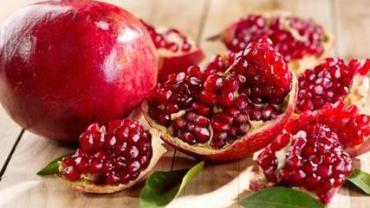
Pomegranates are not the easiest fruits to eat. Unlike apples and peaches you can’t just bite into them. You’ve got to cut one open and then tap on the outside of the fruit in order to release the arils—the juicy sweet seed pods on the inside. An alternative method is to crack the fruit open split it into quarters and let them soak in a bowl of water. Pull out the white pith and the arils will separate easily. This still seems like a lot of work but considering the impressive health benefits of pomegranates it might be worth it.
Pomegranate is a good source of vitamins C and K1. It’s fairly high in sugar though: a half-cup of arils (87g) comes with 16g of carbohydrate and 3g of dietary fiber. Certainly not a “bad” food to eat but one that individuals with poorly managed blood sugar may want to eat in moderation perhaps sprinkled on salads for a pop of sweet-tart flavor. Pomegranate juice is all the rage recently but one cup contains 33g of carbohydrate 32g of which are sugar. As applies to most fruits people are better off eating the whole specimen with its fiber intact rather than isolated liquid sugar. However pomegranate juice may be beneficial for some individuals particularly those with conditions related to fatigue and decreased energy. The juice is rich in citric acid fumaric acid and malic acid—all of which are intermediates in the ATP-producing Krebs cycle.
Aside from the aforementioned two vitamins pomegranate is not all that impressive a source of other nutrients. But that doesn’t mean there’s no place for pomegranate in a healthy diet and supplement regimen. Among the fruit’s long list of potential benefits are improving blood pressure blood lipids oxidative stress hyperglycemia and inflammation erectile dysfunction arthritis and Alzheimer’s disease and there may also be a role for pomegranate compounds in the battle against cancer. Red wine and green tea are celebrated for their antioxidant power but pomegranate is more effective than both of these at scavenging free radicals. The deep red color of pomegranate arils and their juice comes from anthocyanins the same flavonoids that give bold red purple and blue pigments to antioxidant-rich cranberries raspberries blueberries and red onions.
Considering the high sugar content of pomegranate the fruit has a seemingly paradoxical effect on ameliorating some of the factors associated with metabolic syndrome and diabetes. Pomegranate inhibits α-glucosidase an intestinal enzyme that hydrolyzes starch and disaccharides—a mechanism that could reduce postprandial glucose excursions. Another way pomegranate may help with diabetes management is through acting as a natural peroxisome proliferator-activated receptor (PPAR)-γ activator. In Zucker diabetic fatty rats extracts of pomegranate flowers (500mg/kg given orally for six weeks) lowered plasma glucose in response to a glucose load but not fasting glucose levels—perhaps another way to help reduce post-meal glucose spikes. The extract also restored down-regulated GLUT-4 mRNA expression suggesting that pomegranate may have some efficacy in improving insulin sensitivity.
Pomegranate seeds contain about 18% oil 65% of which is punicic acid a triple-unsaturated fatty acid that belongs to the conjugated linolenic acid category. In rats this fat was quickly converted to conjugated linoleic acid better known as CLA a fat that may have benefits for fat loss and chemoprevention. Punicic acid and pomegranate peel extract may help reduce fasting blood sugar. In mouse models of obesity and hyperlipidemia five weeks of supplementation with pomegranate leaf led to significant reductions in body weight total cholesterol triglycerides fasting blood glucose and total cholesterol/HDL ratio.
In mice given an obesity- and insulin resistance-inducing high-fat diet with or without 1% pomegranate seed oil for 12 weeks the pomegranate seed oil-fed group had slightly lower body weight and body fat percentage compared with the mice fed the standard high-fat diet. Researchers also observed a large improvement in peripheral (but not liver) insulin sensitivity in the pomegranate oil-fed group.
It is certainly fascinating that a food relatively high in sugar—and its juice in particular—may have a positive impact on conditions related to hyperglycemia and hyperinsulinemia. Perhaps it is due to pomegranate’s full complement of bioactive compounds including its beneficial oil ellagic acid and other components. As is true with many foods the whole is greater than the sum of its parts.
Other beneficial effects of pomegranate fruit oil juice and peel on the pathologies of diabetes metabolic syndrome cardiovascular disease and cancer come from their anti-inflammatory and antioxidant capacity. A future post will explore these properties.